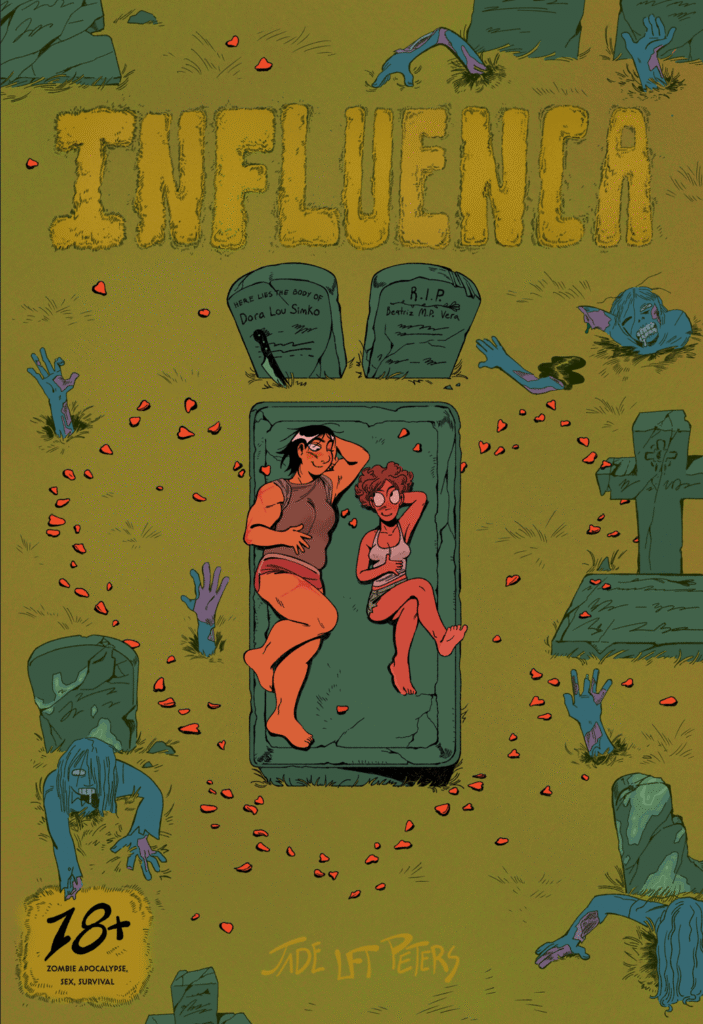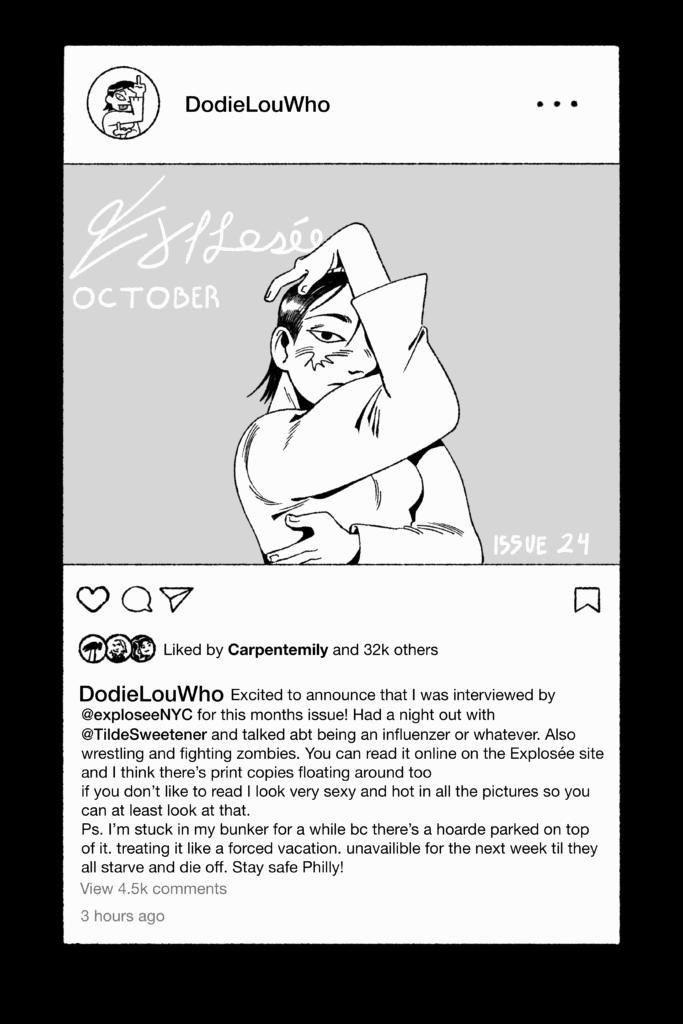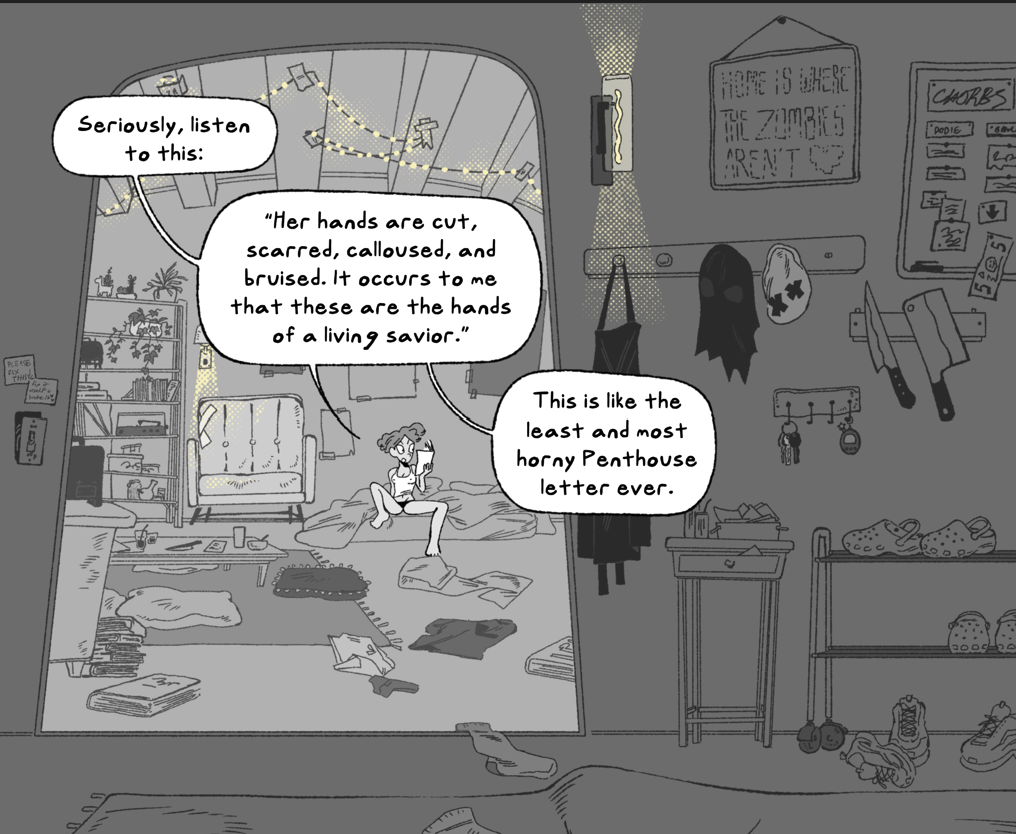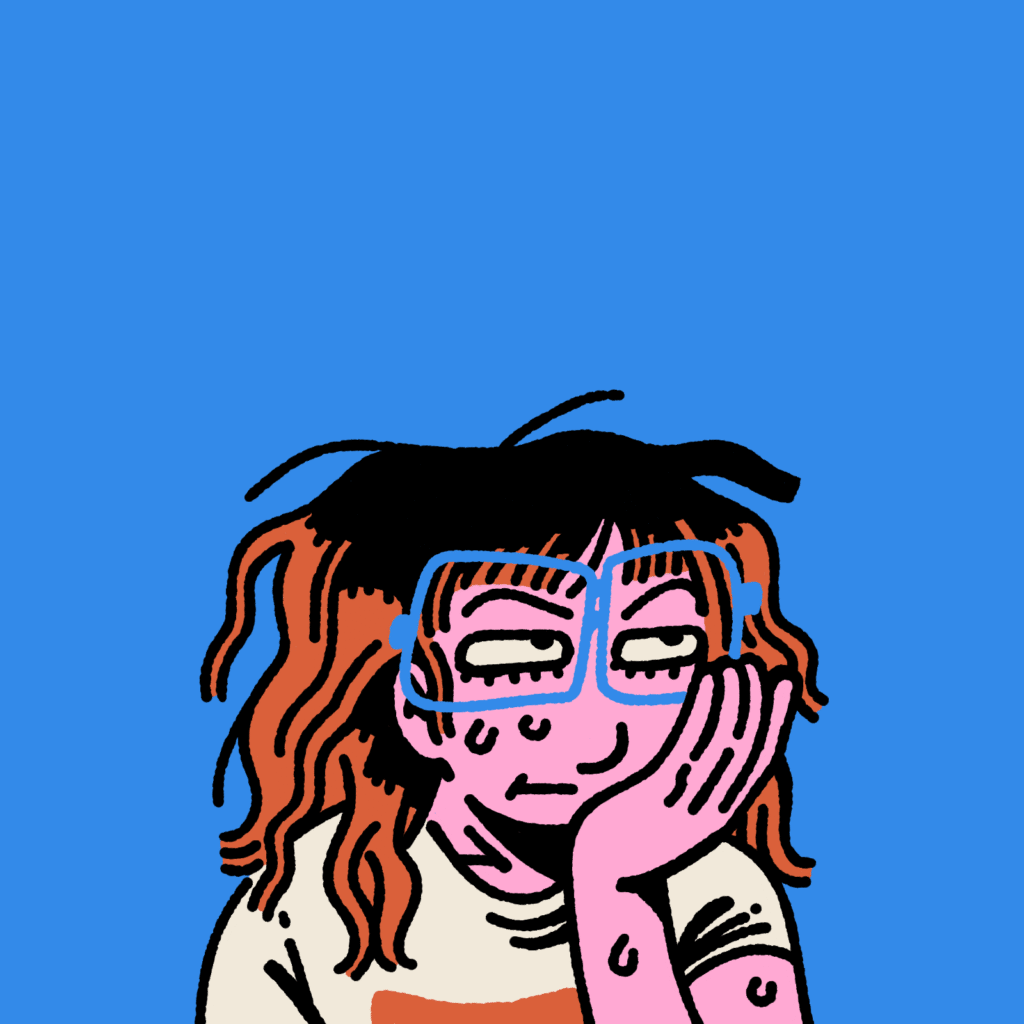by Priya Saxena

Jade LFT Peters’ Influenca is a darkly comedic graphic novel about two women getting by during the zombie apocalypse. Dodie’s athletic background makes her a pro at fighting zombies, and with the social media expertise of her girlfriend, Beatriz, she becomes an influenca: a zombie hunter who uses her social media platform to share survival tips. When a zombie horde camps right outside Dodie and Beatriz’s bunker, the two women are forced to stay inside for a week, and we get a window into the slower, gentler moments of their lives.
Jade LFT Peters discusses Influenca with BoC in this interview. Influenca is out now and available for purchase from Silver Sprocket.
Editor’s note: If you enjoy this interview, be sure to join Queer Spec and BoC on Patreon where Jade LFT Peters recommends 5 titles for BoC’s Required Reading where we ask comic creators to recommend titles for comics, books, TV, and film that either go with or inspired their comic–without explanation! Join us at any tier–including free!!–to unlock access to this great perk!

This is a zombie apocalypse story in which we barely ever see any actual
zombies. One of the things I love about this book is its exploration of finding joy and community in incredibly dire circumstances, and the narrative choice to sideline the zombies themselves in favor of focusing on the survivors and the more mundane aspects of their lives really allows you to emphasize that message. With the zombies mostly out of sight, the apocalypse in this story and its effects on the world become even more similar to the COVID-19 pandemic, where the danger was ever-present and devastating but lacked visible form. How early in the process of creating this story did you decide to shift the focus away from the zombies? Was it a conscious decision, and if so, what was your thought process behind it?
Before I drew anything, I sat down and thought, “I want to make something incredibly self indulgent.” That was the entire basis of Influenca. So, I made lesbian softcore erotica about the zombie apocalypse. Though the lack of zombies was, for the most part, a subconscious choice. That said, there’s a couple layers to why Influenca is zombie-centric but not zombie-forward.
The first stems from my childhood paranoia that the zombie apocalypse was going to happen. Like to the point that I was brainstorming ways to survive the impending apocalypse in elementary school. I used to have these vivid, reoccurring dreams about it. But zombies were very rarely physically present in the dreams—it was more like I had a sense that they were nearby, and I knew with total certainty they were going to get me. But I’d never see more than a glimpse. I’d just have the fear and dread of knowing I and my loved ones were about to die—and I’d wake up right before it happened. The tension of waiting to be attacked at any moment was leagues scarier than a zombie outright biting me. That glimpse of the zombie’s hand through the shower curtains in the very first pages is based off a moment in one of those dreams.
The other reason is COVID-related. When I started working on Influenca, I was
quarantined in Texas with my family and finishing my junior year of college over Zoom. My great-grandmother lived with us, and she was both medically delicate and deep in the throes of late-stage dementia. Hospice came to our home to care for her, she had medical appointments to be brought to, and one of my parents works in medical centers. When someone left the house, I’d think, “Is this the grocery run that gives Mimi COVID?” Or, “Is this the hospice nurse who doesn’t mask properly when she’s not here and gives Mimi COVID?” The virus was suddenly this hostile entity skulking outside our door, waiting to get in and infect my family. And then one of us would have to live with the guilt of being the one to take Mimi out via germs. I would’ve felt less stressed if there were actual zombies lurking around, because I could at least hit a zombie with a baseball bat.

The comic is interspersed with posts from Dodie’s social media. We watch as her follower count grows and her posts become more focused on providing survival advice and spreading awareness of community efforts. Toward the end of the comic, there is also a magazine interview with Dodie, where we get to see her through the interviewer’s eyes. These inserts shake up the narrative of the comic and are also some of the only times we see Dodie and Beatriz communicate with the outside world. Reading Dodie’s social media posts brings me back to that time during lockdown when I could only reach the outside world through my phone or laptop. What role do you see these posts and the interview playing in this story? What were you interested in showing through these inserts that you couldn’t have depicted in a traditional comics narrative?
Oh, from 2020-2022 I clocked into Twitter like it was my day job. It was practically my only contact with people who weren’t related to me. But on the flip side, I was plugged in 24/7 to the catastrophic loss of life from the start of the pandemic. I read so many articles, memorials, and posts about friends and family who died from COVID. Influencers and YouTubers and streamers would pass on, and their profiles and tags would be filled with condolences and recounts of important memories. A few years ago, I found a page about my dead biological father on a website called “MyDeathSpace,” which catalogues dead MySpace users, along with a couple forum posts about him.
Social media is both a form of connection for the living, and a living memorial to the dead. How many people have passed in recent years, whose Facebook pages stand as a way for others to grieve and remember their experiences together? Social media is an organism that survives by adapting to its users’ needs. In Dodie and Bea’s world, I imagined it adopting this new function of being a flare to let your loved ones know if you’re still alive. And if you’re not, then it’s an online space for them to gather and grieve. When you’ve got limited time to reach people, your main goal will shift to reaching as many people as possible all at once. Dodie’s first post is quite literally announcing that she survived the night.
The inclusion of social media posts had a few purposes: showing Dodie’s rise to popularity over time, the progression of her relationship with Beatriz, and to bridge the gap between the first and second halves of Influenca, along with setting up for the interview portion. That last part was added in because I wanted to round out the story, and I thought it would be enjoyable to actually write up the interview they poke fun at throughout the rest of the comic.
Though this is a short graphic novel, I feel like I got to know Dodie pretty well, and some of that has to do with all the different versions of her we see. The comic shows us Dodie at the beginning of the zombie apocalypse, fleeing in terror; Dodie as she presents herself on social media, an ordinary person uplifting and empowering others to keep themselves safe; Dodie as she’s portrayed in her interview, a modest and down-to-earth hero; and Dodie in her bunker, being sweet and teasing with Beatriz. We see how Dodie presents herself differently on social media versus in real life, and through her posts, we can observe how she develops confidence in herself over time. How did you keep Dodie’s voice consistent and recognizable when switching between these different modes of portraying her? What aspects of herself do you think she’s more likely to hide on social media or in public as opposed to when it’s just he and Beatriz?
Our voices change dependent on who we presenting ourselves to, but the
personality stays the same. Dodie is just kind of a regular person who was
accidentally very successful in her niche. Once the core of her character was
established, the rest of it came about naturally. I wrote the middle part first and
added the beginning and interview portions after, so it was like I had already made the “real” Dodie and everything after that was just altering her voice to fit whatever form she was being presented in. Same with Beatriz—they’re their most authentic selves when it’s just them alone together, with no need to perform for other people.
Dodie is more relaxed and chatty with Beatriz. Separately, she’s a little shy and stoic and Beatriz is aloof. But together, they bring out a warmth in each other that they couldn’t show anyone else. It’s a world where you have to be emotionally callous to get through the everyday horrors, but in the safety of their bunker they can indulge their humanity.

Dodie and Beatriz spend a lot of time in their bunker, and understandably, it’s pretty messy. I loved looking at all the little details of how their living space was decorated. My favorites were the “THIS IS WHERE THE ZOMBIES AREN’T” cross-stitch and the knives hanging adjacent to the keys on the wall by the front door. The living space of a character can tell so much about who they are and what their life is like. What did you keep in mind when designing Dodie and Beatriz’s bunker and the way it was decorated? Were there any subtle little details you were hoping readers would notice?
I was the type of kid that would read children’s books over and over, and pore over each illustration and find every little detail. Over 20 years later, I try to make illustrations and comics that people will find a new detail in every time they revisit them. Dodie and Bea are squatting in a bunker someone long-dead built many years before, so they’re just happy to have a private living space (regardless of what it looks like). The home they’ve built as a couple is a reflection of their time together. It’s also an indicator of the importance of function over form in an era where they’re just trying to survive day to day. It’s not a West Elm showroom; they have a lot of stuff crammed in the room, but everything is kind of grimy and damaged. A lot of it would’ve been scavenged or picked up off the curb. Humans like their little knickknacks though, so they still take time to personalize the space.
The cross-stitch is actually my favorite detail… followed closely by the tamagotchi hanging right next to their zombie knives. Beatriz’s complete DIY zombie hunter uniform is only visible in a couple spots, but I hope it stood out to the readers as well.
Influenca features queer love, but more than that, it hones in on queer desire and sexuality. There are all these lovely, indulgent depictions of Dodie and Beatriz in various states of undress, in both sexual and nonsexual contexts. The women are beautiful in a very grounded, tangible way, with scars and skin folds and bruises. Once or twice the women’s desire for each other is implicitly likened to the zombies’ hunger for flesh, though it is a source of joy and comfort rather than destruction. In a zombie apocalypse story, where the horror is so rooted in the physical reality of having a human body, what was your intention in also exploring the beauty and joy of human bodies? Do you find that there is something unique about the ways that queer people appreciate bodies?
Absolutely. To be queer is to experience desire outside of the heteronormative lens. Dodie is fat and buff and unabashedly butch, and is perceived as attractive because of those qualities rather than in spite of them. Human bodies are weird, and made beautiful by their uniqueness. It’s a gift to survive long enough to see yourself and your loved ones age and get wrinkly and old.
Beyond that—isn’t desire another form of hunger? It’s all indulgence in carnal desire at the end of the day. Another turn of phrase for cunnilingus is “eating out;” in my opinion, it’s the most intimate you can be with another person. And it serves no biological purpose other than enjoyment and pleasure. The only step beyond that would be the physical consumption of their bodies, as zombies are given to do. They’re also constantly surrounded by evil corpses shambling around in various stages of nudity and decay, so they’re going to get a little dark humor-y about it.
The bonus comic at the end shows us what Dodie and Beatriz were up to on their first anniversary. We get to see them out on an actual zombie-fighting mission, which is something we never actually see in the main comic. It’s very exciting to see them in action, though I also loved the mundanity of them having to take the bus to get to where the zombies are. What did you enjoy about revisiting these characters in this little adventure for the bonus comic, and what was it important to you to include in this story?
I was really just excited to be drawing them again. Drawing and writing them is always a good time. For the bonus comic I wanted to focus on what their daily life looks like, living and working in the utopia that is Philadelphia (go Birds) and how they acquired their bunker. The original comic is their bottle episode—they‘re stuck alone together in one location, though there’s glimpses of their normal routine through the social media posts and backstory. The extra follows up with them actually doing the job they talked about so much. And with that, it also shows how quickly society restructured to casually accept zombies as an unavoidable facet of life.
If readers want to learn more about you and your comic work, where can they find you online?
I’m @pokoglio on Instagram/Bluesky/Tumblr/Twitter etc (though that last one is subject to change).

Jade LFT Peters is an illustrator and cartoonist raised somewhere in Texas who moved to somewhere on the East Coast and now refuses to leave. Their narrative work focuses on the horrors and joys of the human experience and the absurdity of mundane life. Outside of illustration, they enjoy trying and failing to raise a sourdough starter and logging hundreds of hours into Stardew Valley.
Priya Saxena (she/her or they/them) is a writer and critic based in New York City who enjoys reading queer comics and watching campy television. You can follow them on Twitter at @lettersofpriya.

Comments are closed, but trackbacks and pingbacks are open.